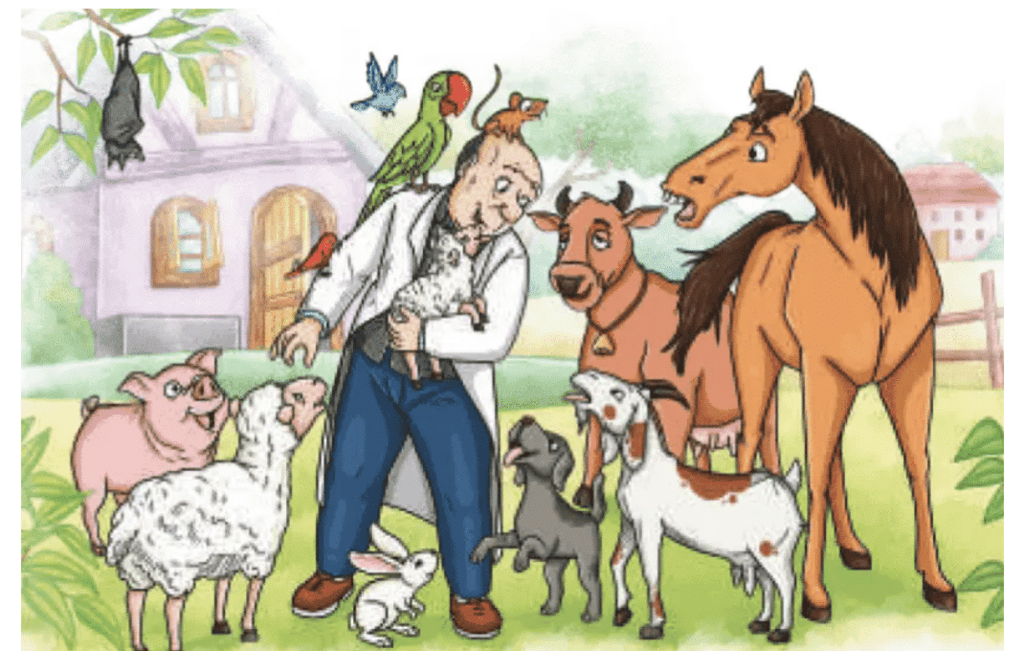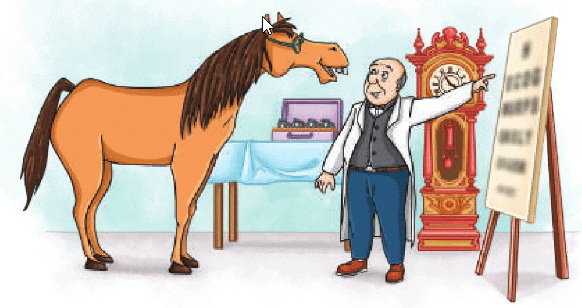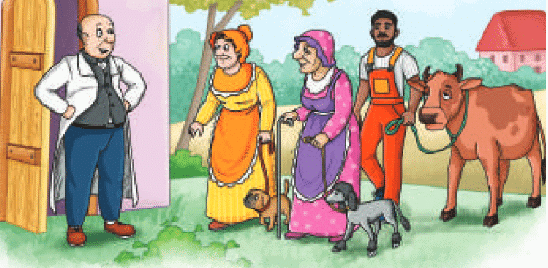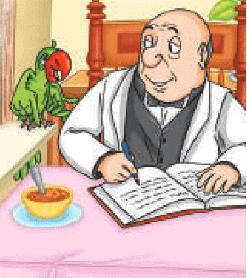Multiple Choice Questions (MCQs)
Q1: Who is the author of “The Story of Doctor Dolittle”?
a) Helen Keller
b) Hugh Lofting
c) Eliza Cook
d) Kamala Nair
Ans: b) Hugh Lofting
The story is written by Hugh Lofting.
Q2: Who is the first to suggest that Doctor Dolittle should become an animal doctor?
a) Jip the dog
b) Polynesia the parrot
c) A farmer
d) The Cat’s-food-Man
Ans: d) The Cat’s-food-Man
The Cat’s-food-Man, while discussing his stomach ache, suggests that Dolittle should become an animal doctor due to his knowledge of animals. Polynesia, the parrot, agrees but is not the first to suggest it.

Q3: What problem does the plough horse have?
a) A sore foot
b) Blindness in one eye
c) A stomach ache
d) A broken leg
Ans: b) Blindness in one eye
The plough horse complains to Dolittle that he is going blind in one eye, and Dolittle provides green spectacles to help.
Q4: How do animals communicate, according to Polynesia?
a) Only through sounds
b) Through ears, tails, feet, and noses
c) Only through their eyes
d) Through written messages
Ans: b) Through ears, tails, feet, and noses
Polynesia explains that animals communicate using their ears, tails, feet, and noses, not just sounds or eyes, and definitely not written messages, which are not part of animal communication.
Q5: What does the word “diagnose” mean in the story?
a) To make someone healthy
b) To find out what is wrong
c) To teach a language
d) To build a tunnel
Ans: b) To find out what is wrong
The word “diagnose” is defined in the story as finding out what is wrong with someone or something, as Dolittle does with the plough horse.

Fill in the Blank
Q1: Doctor Dolittle learns to speak _______ languages.
Ans: animal
Q2: Polynesia teaches Dolittle the basics of _______ language first.
Ans: bird
Q3: The plough horse is given _______ spectacles to help him see.
Ans: green
Q4: Dolittle builds special _______ for different animals to manage the crowd.
Ans: doors
Q5: The word “twitching” refers to small, quick _______.
Ans: movements
True or False
Q1: Doctor Dolittle starts as an animal doctor before treating people.
Ans: False
Dolittle begins as a people’s doctor and only becomes an animal doctor after the Cat’s-food-Man’s suggestion.
Q2: Polynesia reveals that animals have their own languages.
Ans: True
Polynesia shares the secret that animals have their own languages, teaching Dolittle to understand them.
Q3: The plough horse needs medicine to fix his problem.
Ans: False
The plough horse needs glasses, not medicine, for his blindness in one eye.
Q4: Dolittle becomes famous only among people.
Ans: False
Dolittle becomes famous among animals worldwide, not just people.
Q5: The word “veterinarians” means doctors who treat animals.
Ans: True
The story defines “veterinarians” as doctors who treat animals, like the local vet mentioned.

Very Short Answer Questions
Q1: What is the name of Doctor Dolittle’s parrot?
Ans: Polynesia
Q2: Who brings sick pets to Doctor Dolittle?
Ans: People
Q3: What animal complains about the local vet?
Ans: Plough horse
Q4: What does the word “cure” mean in the story?
Ans: To make healthy again
Q5: What spreads the news of Dolittle’s skills across countries?
Ans: Birds
Long Answer Questions
Q1: How does Polynesia help Doctor Dolittle become an animal doctor?
Ans: Polynesia, the parrot, plays a crucial role in Doctor Dolittle’s transition to becoming an animal doctor. She overhears the Cat’s-food-Man’s suggestion and enthusiastically supports it, encouraging Dolittle to focus on animals. She reveals the secret that animals have their own languages and begins teaching him bird language on a rainy afternoon, explaining how animals communicate through ears, tails, feet, and noses. With her guidance and patient instruction, Dolittle learns to speak and understand animal languages fluently, giving him the skills and confidence to officially become an animal doctor, fulfilling his new purpose.

Q2: Describe how Doctor Dolittle helps the plough horse and what this shows about his skills.
Ans: Doctor Dolittle helps the plough horse by listening carefully to its complaint that the local vet cannot understand its problem. He diagnoses that the horse is going blind in one eye and, instead of prescribing medicine, provides green spectacles to improve its vision, allowing it to work comfortably again. This shows Dolittle’s unique skills as an animal doctor, particularly his ability to communicate directly with animals to understand their needs accurately. His creative solution—glasses for a horse—demonstrates his innovative thinking and deep care for animals’ well-being.
Q3: Explain how Dolittle manages the large number of animals visiting him.
Ans: As Dolittle’s reputation grows, his garden becomes crowded with animals like mice, badgers, and bats seeking his help. To manage this large number, he builds special labelled doors and tunnels tailored for different animals, ensuring organised access to his services. This system allows him to efficiently handle the influx of patients, from small creatures to larger ones like cows and sheep. His thoughtful approach shows his ability to adapt and maintain order, ensuring all animals receive care despite the overwhelming demand.
Q4: What is the moral of the story, and how does Dolittle’s journey reflect it?
Ans: The moral of the story is that listening to new ideas and showing kindness to all creatures can lead to happiness and success. Dolittle’s journey reflects this as he embraces the Cat’s-food-Man’s, and Polynesia’s suggestion to become an animal doctor, despite initially treating people. By learning animal languages and caring for creatures like the plough horse, he finds fulfilment and becomes famous among animals worldwide. His openness to change and dedication to understanding animals demonstrate how embracing new perspectives and compassion can transform one’s life and impact others positively.
Q5: Discuss how the story highlights the importance of understanding and caring for animals.
Ans: The story highlights the importance of understanding and caring for animals through Doctor Dolittle’s transformation into an animal doctor. His ability to learn animal languages, guided by Polynesia, allows him to communicate directly with creatures like the plough horse, addressing their needs accurately, such as providing glasses instead of medicine. The growing number of animals seeking his help, from mice to bats, shows their trust in his care. Dolittle’s efforts to build special doors and tunnels for them further demonstrate his respect and compassion, emphasising that understanding animals’ perspectives and treating them kindly fosters a harmonious relationship and brings joy to both the caregiver and the animals.